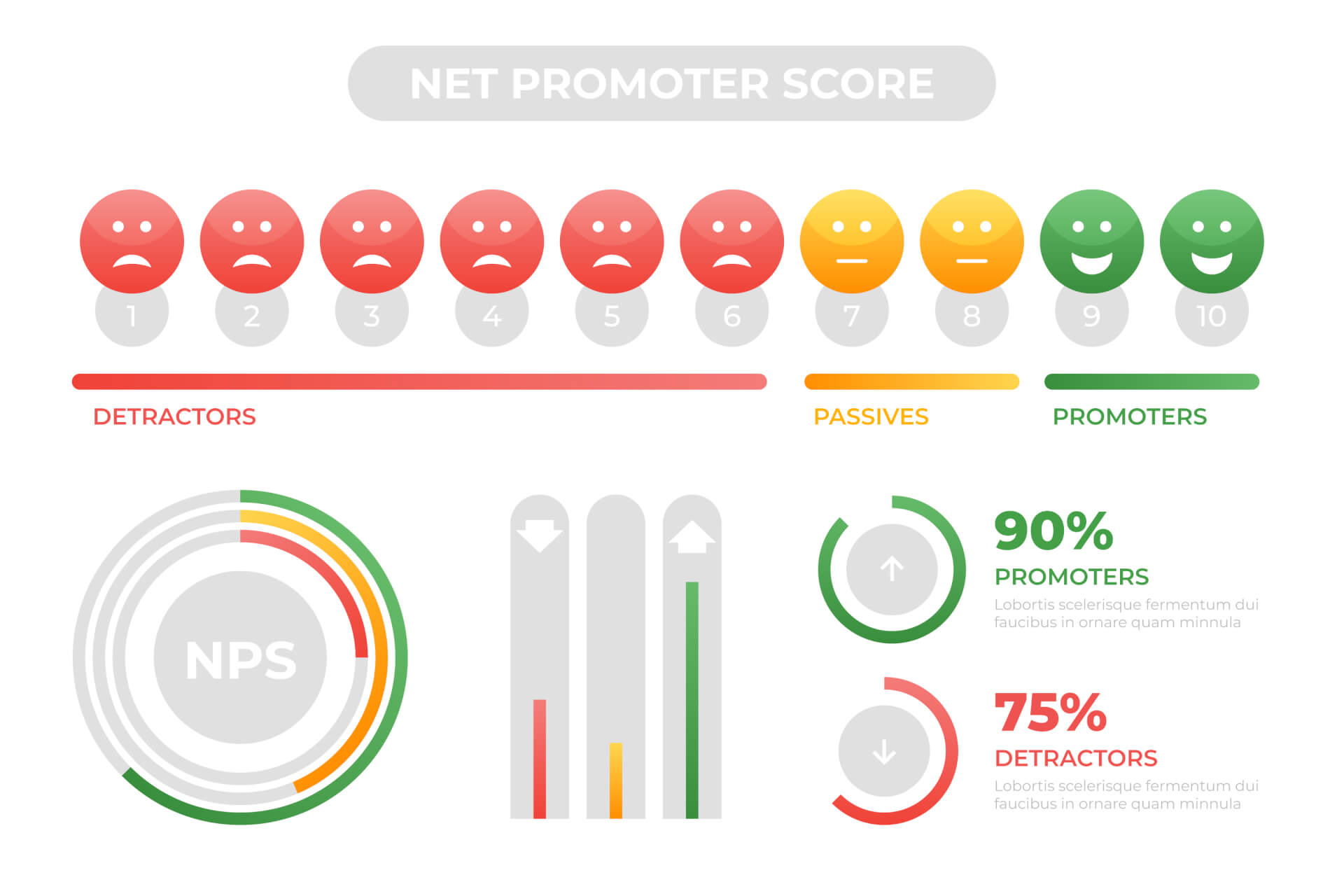 With Net Promoter Score surveys you measure the likelihood that a customer will recommend your company to their personal and / or professional environment. The higher the resulting NPS® value, the higher the chance of a recommendation, as well as a sign that your customers have become active promoters for your company.
With Net Promoter Score surveys you measure the likelihood that a customer will recommend your company to their personal and / or professional environment. The higher the resulting NPS® value, the higher the chance of a recommendation, as well as a sign that your customers have become active promoters for your company.
As an e-commerce company, you can theoretically do without NPS customer surveys, but you can be much more successful if you use NPS surveys to increase customer loyalty and thus also sales.
Winning and retaining a loyal, satisfied customer is rarely something that happens by chance.
In practice, it is the result of a conscious, scalable process. With NPS, you get a much deeper understanding of how efficient your existing marketing process is in attracting customers.
So that you can evaluate whether you are incorporating NPS into your eCommerce customer acquisition and retention processes in order to acquire more customers and retain them for longer, the following are some examples of using the Net Promoter Score.
Table of Contents
- Survey all customers, not just the top 10
- Don't think too much about statistics
- Focus on improvement, not on beating the NPS score from the last survey.
- Look for more than just the score
- Always close the customer feedback loop
- Calculate how much each promoter is worth
- Get started with NPS surveys now to grow your business
Survey all customers, not just the top 10
 For a good calculation of your Net Promoter Score, it is important to ask a representative sample from the cross-sum of your customer base.
For a good calculation of your Net Promoter Score, it is important to ask a representative sample from the cross-sum of your customer base.
If you only interview a certain group of your customer base with your NPS survey, this will lead to an artificially high or low NPS score, which actually makes it impossible for you to take efficient and profitable action.
If you offer to purchase your products, for example, by ordering as a “guest”, i.e. without registering, then it is important to ask these customers as well. If you only direct the NPS surveys to registered customers, the NPS score will be falsified and will not give you any information as to why this part of your customers does not want to register.
NPS depends on the consistency of the surveys. It is important that you not only get a representative cross sum of your customers, but that you also use a consistent NPS process to avoid skewing results.

Reading recommendation: The feedback you receive will help you identify weak points and improve processes. In the following article we explain "Why you should also talk to your detractors."
Don't think too much about statistics
 Compared to a simple yes / no survey, the NPS needs more data to come to a representative result.
Compared to a simple yes / no survey, the NPS needs more data to come to a representative result.
If you only ask a small number of customers, there is a risk that this will result in a score that cannot exactly reflect the customer's sentiment. The smaller your pool of respondents, the higher the risk that the value obtained does not correspond to the real situation.
Make sure that you adapt the frequency of the surveys and your evaluation to your own sales volume. With a small audience, monthly fluctuations in your NPS can be the result of simple statistical noise instead of real data. Therefore, make sure that the target group surveyed is large enough to receive statistically significant data. Specifically, for smaller traders, this means that you should take a longer-term approach to tracking progress, simply to avoid false positives.
Since the NPS is a very volatile metric that can quickly become out of date, focus your primary activities on closing the customer feedback loop by addressing customer-reported issues, resolving them in a timely manner, and informing the customer about them.
This approach has greater effects on your e-commerce company than a purely statistically recorded NPS survey result.
Focus on improvement, not on beating the NPS score from the last survey.

NPS benchmarks are useful for estimating the range your Net Promoter Score can fall into. However, you should not use the score to benchmark your company against its competitors and assess its performance. Most NPS benchmark reports group companies into broad categories.
For example, small e-commerce stores are placed in the same category as giants like Amazon.
Therefore, the average NPS in your category may not accurately reflect the type of experience customers have with your business. Instead of focusing on beating the average, you better focus on improving your own Net Promoter Score over the long term.
Look for more than just the score
Unfortunately, the Net Promoter Score's greatest strength - its simplicity - also has the potential to be its major weakness.
Of course, it's easy to focus entirely on the sheer value of your Net Promoter Score to move the number up at any cost. Ultimately, however, you would miss the actual purpose and goal of a survey using NPS, namely to measure the customer experience and customer satisfaction and to continuously improve them through direct measures.
In e-commerce, a single factor can often turn a positive experience into a negative one. Slow shipping, poor packaging, or product photos that don't accurately reflect the actual item are often enough to turn a potential ten into a one.
So don't just look at the numbers when checking your NPS. Review comments from customers, especially your critics. In doing so, you will often discover the small but significant flaws in your sales, payment, and order fulfillment processes that affect the customer experience.
Always close the customer feedback loop
 The most important element of working with the Net Promoter System is closing the loop: a process of taking action and responding directly to a customer's concern, complaint, or praise.
The most important element of working with the Net Promoter System is closing the loop: a process of taking action and responding directly to a customer's concern, complaint, or praise.
If a reviewer gives his or her opinion and gives your company a low score, act as soon as possible. An effective service recovery process to restore satisfaction can help you win back customers who feel unhappy or badly treated, and even turn them into happy, enthusiastic promoters.
Statistical measurements have shown that an increase in customer loyalty by just 5% can lead to a profit improvement of 25 to 95%!
As an e-commerce retailer, setting up a service recovery process to close the customer feedback loop with critics should be one of the first steps you take after implementing NPS surveys.
Calculate how much each promoter is worth
One of the most important steps in using NPS to improve customer acquisition in e-commerce is calculating the value of your promoters.
By implementing a referral program that encourages word of mouth, you can keep track of the revenue each promoter is making for your business.
This allows you to calculate a lifetime promoter value over time that is similar to the Customer Lifetime Value (CLV) used for customer acquisition.
Quantifying the value of promoters is an important step in the long-term implementation of NPS as it quantifies the value of delivering a great experience. Instead of just knowing that when your customer becomes a promoter it's great, you can assign a value to each new promoter.
Get started with NPS surveys now to grow your business
When used effectively, the Net Promoter Score will help you retain customers, gain more brand advocates, and get more details about the experience your ecommerce business has to offer its customers.
Callexa makes it easy for you to measure customer satisfaction and grow your e-commerce business.
Start surveying your customers and calculate your Net Promoter Score today!
 Reading recommendation: If this article helped you and you would like to find out more about the Net Promoter Score, continue reading here: “The Net Promoter Score – Basics and Areas of Application”
Reading recommendation: If this article helped you and you would like to find out more about the Net Promoter Score, continue reading here: “The Net Promoter Score – Basics and Areas of Application”